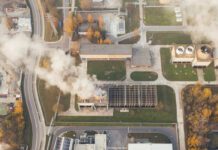Dr Steven Goodman of monitoring expert Shaw City appraises the limitations with many existing ground gas monitoring programmes, and the opportunities that now exist to better understand what’s happening, through the use of continuous monitoring instruments

A ground gas risk assessment is often undertaken at the outset of a construction site’s development. This is usually required by the local planning authority and subsequently undertaken by a developer or their contractor. Spot monitoring visits can continue for up to 12 months or more, if methane is found at over 5% by volume.
Such a monitoring programme has to determine the actual ground gas regime and how it is likely to change in the future. In other words, it is not just a screening exercise. At present, it is most commonly carried out via discrete periodic static measurements of ground gas concentrations, from which a ground gas regime is inferred. However, this discrete-measurements approach is inherently flawed, being unable to accurately measure ground-gas concentrations and ground-gas fluxes. Neither are measured directly and both are likely to vary over time.
Measurement is indirect since ground-gas concentration is inferred from periodic sampling of gas accumulated within a borehole and flux is then inferred from these borehole gas concentrations. The unit of flux is volume/time, therefore it cannot be determined without time series data. With the ability to collect time series data, an improved measurement of flux can be made and temporal variability in ground gas concentrations can be quantified and accounted for.
This will provide an improved understanding of the processes under observation, thereby reducing the uncertainty implicit in using measurements that are indirect. Contaminated land and landfill industry regulators recognise the need for more representative data but cost has prevented the collection of continuous records of ground-gas measurements.
However, technologies are appearing which permit continuous ground gas monitoring, such as the GasClam landfill gas monitor (pictured, right), available from monitoring expert Shaw City.
Uncertainties with the conventional approach
The current approach relies on making discrete measurements of concentration from which representative ground gas concentrations and gas migration potential can be inferred. However, as system data is poorly resolved temporally, uncertainties in these inferences remain large. For example, the frequency of variation in gas concentration may be higher than the sampling frequency, in which case measurement will not be representative.

Continuous monitoring can overcome this mismatch. Importantly, time-series data can also reveal that the frequency of variation in gas concentration is highly variable.
Linking gas concentration and other environmental variables
With higher time-axis resolution of not only gas concentration but also other environmental variables it becomes possible to observe their inter-relationships more clearly. This in turn makes it easier to predict how gas concentration will change as other parameters change. Atmospheric pressure is considered to be a strong driving force for gas migration (Wilson et al, 2008). In general it is assumed that concentrations are higher when pressure is low and vice versa. Existing guidance (e.g. CIRIA Report 665) recommends collecting at least one spot sample below 1000mbar in falling pressure. However, continuous ground gas measurements reveal the arbitrary nature of the 1000mbar limit: Concentration levels change continuously with variations in atmospheric pressure, rather than displaying a clear dependency on the absolute atmospheric pressure.
Furthermore, under some conditions this assumed relationship between pressure and concentration doesn’t exist – an inverse relationship between the two has even been observed.
So, the ability to monitor environmental parameters and gas concentration simultaneously can provide an understanding of the processes contributing to ground-gas production and migration. Initial results suggest that the relationship between environmental parameters and this gas concentration are complex and currently poorly understood.
As further understanding of the underlying processes is unearthed, it will be possible to build more representative conceptual models. This will also benefit risk assessment, which is currently based on a patchwork of inferences made about worst-case conditions determined by periodic measurements of gas concentration.
Organic compounds risk
In many situations it is also important to consider the risk of organics contamination in ground gas in the form of volatile organic compounds (VOCs). These can easily be ignored or misidentified due to ground gas monitors mistakenly identifying them as methane (CH4). This can occur as a result of infrared absorbance measurements detecting the methyl groups present on most organic compounds (as well as methane).
Photo-ionisation detectors (PIDs) are often used to identify the presence of organic compounds by spot-sampling the ground gas. This can be very useful as an initial screening exercise if methane levels are genuinely below approximately 4% by volume. Any concentration close to this renders a PID impotent due to methane absorbing the UV output of the PID lamp. Hence, VOC analysis has to be undertaken, either through grab sampling or laboratory analysis.
Continuous on-site analysis of VOCs is becoming more practical. One instrument that is being used here is the Frog 4000 from Defiant Technologies (pictured, above). This unit allows for VOC analysis to laboratory standards. It can be used for both qualification and quantification of organic vapours. Target analytes can be separated and detected in less than five minutes.
The promise of continuous monitoring
Continuous gas-monitoring data has revealed several potential flaws with existing monitoring methodologies. Ground-gas regimes appear to vary, depending on the conditions present on
the site. So it can be difficult to identify a sampling frequency that will allow measurements to capture the variability in gas concentrations.
New varieties of instrument that permit on-site field analysis of VOCs in boreholes hold forth the promise of gaining a much fuller understanding of the nature of ground gas emissions and the potential problems presented by organic compounds, with their potential to contaminate groundwater and soils.






